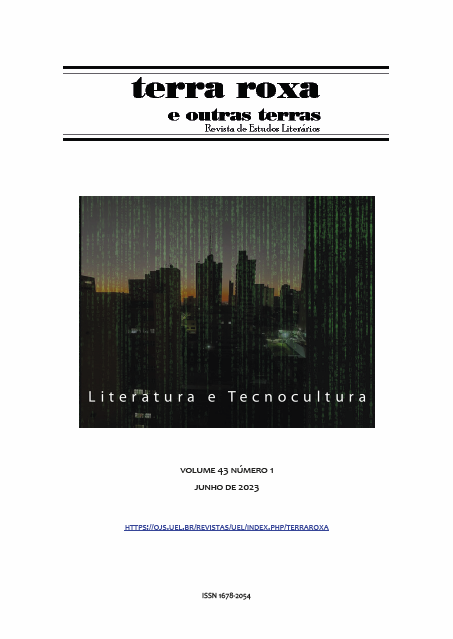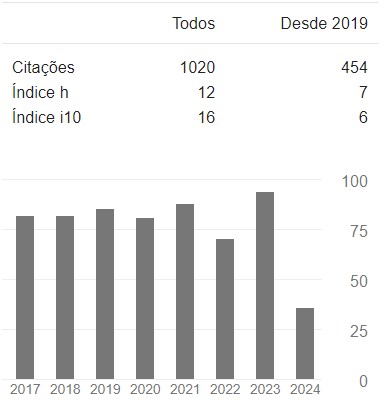Images of the unimaginable: Imaginary Media and Digital Technology in Cinema
DOI:
https://doi.org/10.5433/1678-2054.2023vol43n1p67Keywords:
Cinema, Imaginary Media, Digital technologyAbstract
Throughout its history, cinema has constantly incorporated images of of itself as a medium and of other media, either those that precede it (such as painting and photography) or those that are contemporaneous with it (video or TV). After a revision of how those images are articulated starting from what Huhtamo has called “media tropes”, this essay explores how several films feature images of imaginary media that are characterized by their immediacy (in Bolter & Grusin’s sense), by their dangerous effects on users’ consciousness and by the way in which they blur the limits between media, body, and subjectivity. The films that will be analyzed are Douglas Trumbull’s Project Brainstorm, Wim Wenders’ Until the End of the World, Kathryn Bigelow’s Strange Days, David Cronenberg’s eXistenZ, and Lisa Joy’s Reminiscence. These fictions are read as attempts to articulate in visual terms the impact of digital media on subjectivity, culture, and other media absorbed by it, such as cinema.
Downloads
References
BOLTER, Jay David & Richard Grusin. Remediation: Understanding New Media. Cambridge: MIT Press, 2000.
CHERCHI USAI, Paolo. The Death of Cinema. History, Cultural Memory, and the Digital Dark Age. London: British Film Institute, 2001. DOI: https://doi.org/10.5040/9781838710125
FOSTER, Hal. The Return of the Real. Cambridge. Massachusetts: MIT Press, 1996.
HOBERMAN, James. El cine después del cine, o ¿qué fue del cine en el siglo XXI? Barcelona: Paidós, 2014.
HUHTAMO,Erkki. Dismantling the Fairy Engine: Media Archeology as Topos Study. Erkki Huhtamo & Jussi Parikka. Media Archeology: Approaches,Applications, and Implications. eds. Berkeley: U of California P, 2011. 27-47. DOI: https://doi.org/10.1525/9780520948518
HUHTAMO, Erkki. Elements of Screenology: Toward an Archaeology of the Screen. ICONICS: International Studies of the Modern Image, vol.7, p. 31-82, 2004. Tokyo: The Japan Society of Image Arts and Sciences.
KLUITENBERG, Eric. On the Archaeology of Imaginary Media. Erkki Huhtamo & Jussi Parikka. Media Archeology: Approaches,Applications, and Implications. eds. Berkeley: U of California P, 2011. 48-69.
LE GUIN, Ursula K. The Left Hand of Darkness. New York: Penguin, 2016.
MACHADO, Arlindo. Pre-cine y post-cine. En diálogo con los nuevos medios digitales. Buenos Aires: La Marca, 2015.
MCLUHAN, Marshall. Comprender los medios de comunicación. Las extensiones del ser humano. Barcelona: Paidós, 1996.
MERÁS, Lidia. Paraísos artificiales: la utopía cibernética en eXistenZ. L’Atalante: revista de estudios cinematográficos, n. 18, p. 102-110, 2014.
FISHER, Mark. Work and Play in eXistenZ. Film Quarterly, v. 65, n. 3, p. 70–73, 2012. DOI: https://doi.org/10.1525/fq.2012.65.3.70
RODOWICK, David N. The Virtual Life of Film. Cambridge: Harvard UP, 2007. DOI: https://doi.org/10.4159/9780674042834
SADIN, Éric. La humanidad aumentada. La administración digital del mundo. Buenos Aires: Caja Negra, 2018.
YOUNGBLOOD, Gene. Cine expandido. Buenos Aires: UNTREF, 2012.
Filmografía (ordem cronológica)
Tron, dirigido por Steven Lisberger, 1982.
Brainstorm, dirigido por Douglas Trumbull, 1983.
Until the End of the World, dirigido por Wim Wenders, 1991.
Strange Days, dirigido por Kathryn Bigelow, 1995.
eXistenZ, dirigido por David Cronenberg, 1999.
Matrix, dirigido por Lana Wachowsky & Lily Wachowski, 1999.
Reminiscence, dirigido por Lisa Joy, 2021.
Downloads
Published
How to Cite
Issue
Section
License
Copyright (c) 2023 Fernando Pérez

This work is licensed under a Creative Commons Attribution 4.0 International License.
Authors who publish in this journal agree to the following terms:
a) The authors retain the copyright and grant the journal the right of first publication, the work being simultaneously licensed under the Creative Commons Attribution-NonCommercial 4.0 International License, allowing the sharing of the work with acknowledgment of the authorship of the work and initial publication in this journal.
b) Authors are authorized to assume additional contracts separately, for non-exclusive distribution of the version of the work published in this journal (eg, publish in an institutional repository or as a book chapter), with acknowledgment of authorship and initial publication in this journal.
c) Authors are allowed and encouraged to publish and distribute their work online (e.g. in institutional repositories or on their personal page) after the editorial process, as this can generate productive changes as well as increase impact and citation of the published work (See The Effect of Open Access).
d) The authors of the approved works authorize the journal to, after publication, transfer their content for reproduction in content indexers, virtual libraries and the like.
e) The authors assume that the texts submitted for publication are of their original creation, taking full responsibility for their content in case of any objection by third parties.



















